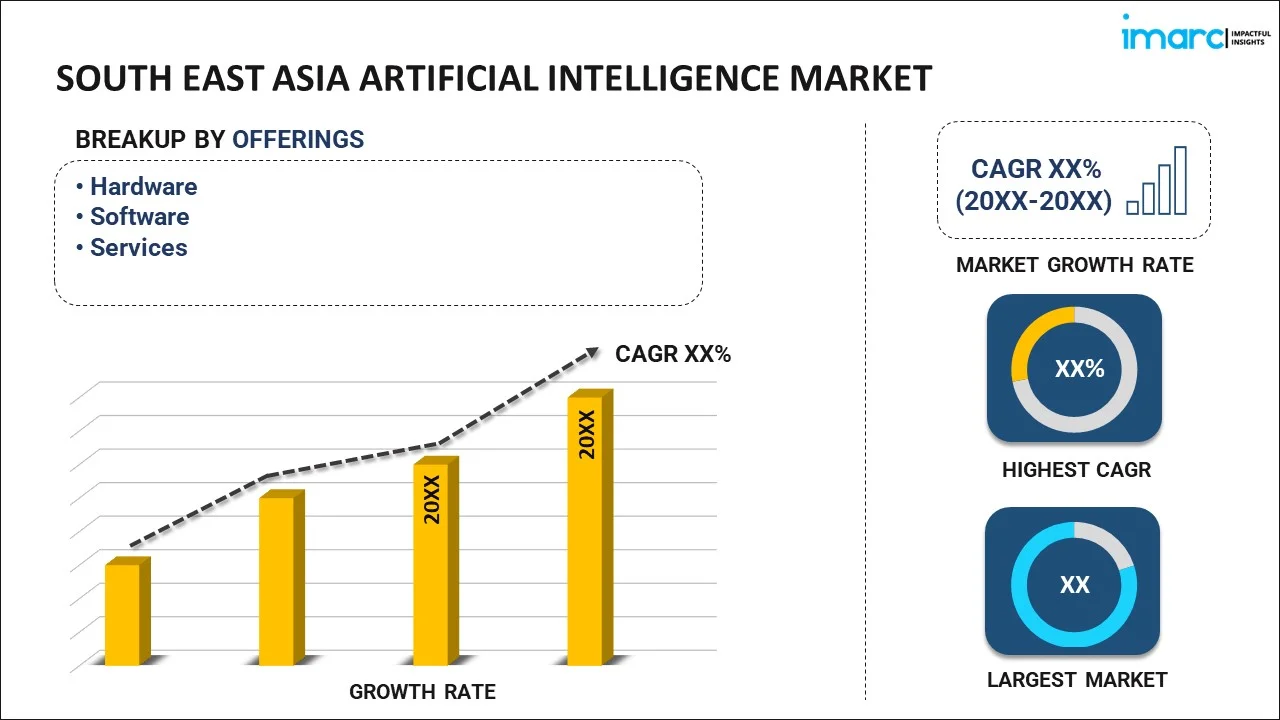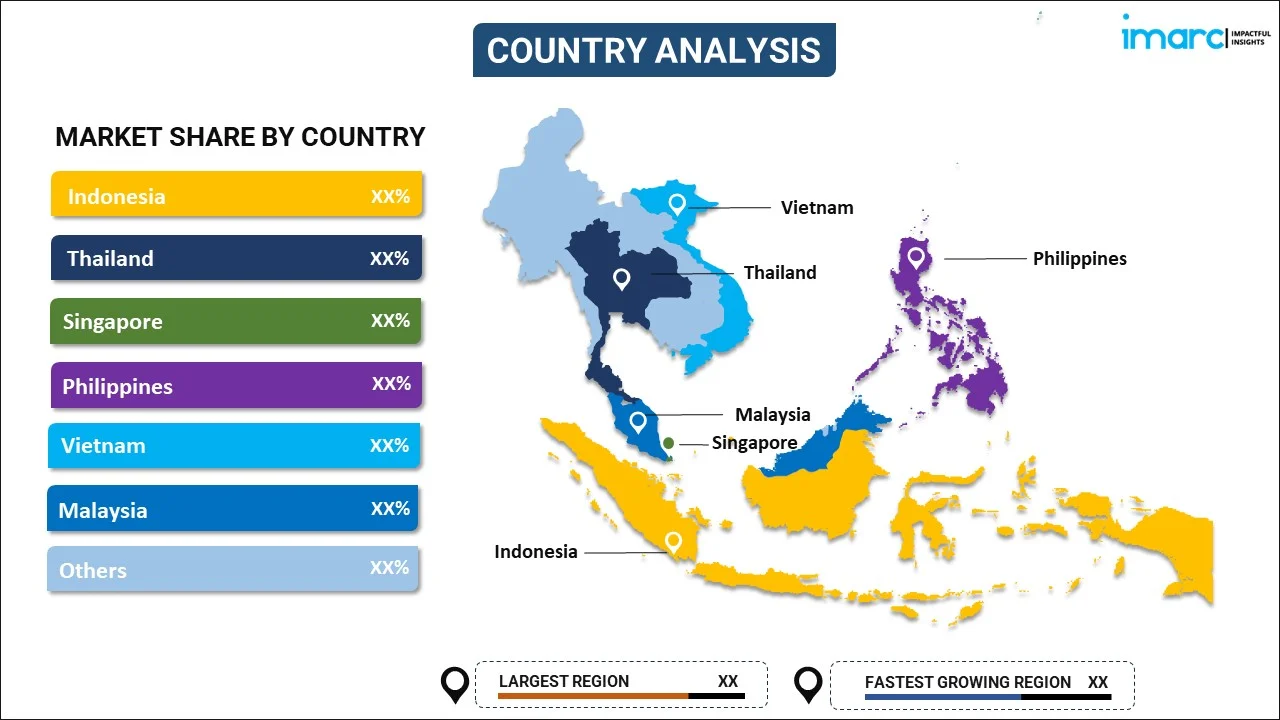
South East Asia Artificial Intelligence Market Report by Offering (Hardware, Software, Services), Technology (Machine Learning, Natural Language Processing, and Others), End Use Industry (IT and Telecom, Healthcare, Retail and E-Commerce, Logistics and Transportation, Manufacturing, Consumer Electronics, BFSI, and Others), and Country 2025-2033
Market Overview:
South East Asia artificial intelligence market size is projected to exhibit a growth rate (CAGR) of 16.59% during 2025-2033. The increasing efforts toward regional integration, the rising cultural acceptance of technology and a growing awareness of AI's potential benefits, the expanding e-commerce landscape, the escalating focus on sustainable development, and the rising importance of cybersecurity in the digital era are some of the factors propelling the market.
|
Report Attribute
|
Key Statistics
|
|---|---|
|
Base Year
|
2024 |
|
Forecast Years
|
2025-2033
|
|
Historical Years
|
2019-2024
|
| Market Growth Rate (2025-2033) | 16.59% |
Artificial Intelligence (AI) is the culmination of human ingenuity and technological prowess, representing a frontier where machines emulate and, sometimes, exceed human cognitive functions. At its core, AI involves the creation of algorithms and systems that enable machines to learn, reason, and perform tasks traditionally associated with human intelligence. Unlike conventional programming, where specific instructions dictate a machine's actions, AI systems leverage data to recognize patterns, make predictions, and continuously improve their performance through a process known as machine learning. Machine learning, a subset of AI, empowers systems to evolve and adapt without explicit programming, learning from experiences and data inputs. This adaptability is fueled by neural networks inspired by the human brain, with layers of interconnected nodes that process information analogous to human thought processes. Deep learning, a sophisticated machine learning, employs these multi-layered neural networks to tackle intricate problems, such as image and speech recognition, with remarkable accuracy. AI applications are as diverse as they are transformative, permeating various aspects of our lives. From virtual assistants like Siri and Alexa, who understand and respond to natural language, to recommendation systems that tailor content to individual preferences, AI shapes how we interact with technology. Moreover, industries ranging from healthcare and finance to manufacturing and transportation harness AI for enhanced decision-making, automation, and problem-solving. It represents a frontier where human creativity converges with technological innovation, promising a future where machines augment our capabilities and redefine the possibilities of what can be achieved.
South East Asia Artificial Intelligence Market Trends:
The market in South East Asia is majorly driven by the increasing commitment to technological advancement and economic progress. In line with this, the governments across South East Asia are actively promoting and supporting the development of AI. They are investing in research and development, creating regulatory frameworks, and offering incentives to encourage businesses and startups to adopt and innovate with AI technologies. Furthermore, the region's rapid economic growth and the ongoing transformation of industries are fostering a conducive environment for AI adoption. As South East Asian nations transition from traditional economies to more technologically advanced ones, businesses increasingly turn to AI to enhance productivity, efficiency, and competitiveness. Besides, the growing digitalization of economies in South East Asia, coupled with widespread connectivity, is accelerating the adoption of AI technologies. Increased access to high-speed internet and the proliferation of smartphones create a fertile ground for the deployment of AI applications, ranging from e-commerce and fintech to smart city solutions. Moreover, the region is witnessing a rise in tech talent, with a growing number of skilled professionals entering the AI field. Educational initiatives, coding boot camps, and collaborations between academia and industry are contributing to the development of a robust AI workforce essential for the region's sustained growth in the AI sector. Collaborative efforts between industries, research institutions, and governments drive AI market growth. Partnerships between tech companies, startups, and traditional industries are fostering innovation and the development of AI solutions tailored to South East Asia's unique challenges and opportunities. Additionally, the region is keenly interested in emerging technologies such as the Internet of Things (IoT), blockchain, and robotics, often integrated with AI. This convergence of technologies amplifies the transformative potential, enabling smart solutions in agriculture, healthcare, logistics, and other sectors. The region is also witnessing a rise in investment in AI startups. Venture capital firms and multinational corporations recognize the potential in South East Asia's expanding AI ecosystem, injecting capital into innovative ventures that drive technological advancements and market growth.
South East Asia Artificial Intelligence Market Segmentation:
IMARC Group provides an analysis of the key trends in each segment of the market, along with forecasts at the regional and country levels for 2025-2033. Our report has categorized the market based on offering, technology, and end use industry.
Offering Insights:

- Hardware
- Software
- Services
The report has provided a detailed breakup and analysis of the market based on the offering. This includes hardware, software, and services.
Technology Insights:
- Machine Learning
- Natural Language Processing
- Others
A detailed breakup and analysis of the market based on the technology have also been provided in the report. This includes machine learning, natural language processing, and others.
End Use Industry Insights:
- IT and Telecom
- Healthcare
- Retail and E-Commerce
- Logistics and Transportation
- Manufacturing
- Consumer Electronics
- BFSI
- Others
The report has provided a detailed breakup and analysis of the market based on the end use industry. This includes IT and telecom, healthcare, retail and e-commerce, logistics and transportation, manufacturing, consumer electronics, BFSI and others.
Country Insights:

- Indonesia
- Thailand
- Singapore
- Philippines
- Vietnam
- Malaysia
- Others
The report has also provided a comprehensive analysis of all the major regional markets, which include Indonesia, Thailand, Singapore, Philippines, Vietnam, Malaysia, and Others.
Competitive Landscape:
The market research report has also provided a comprehensive analysis of the competitive landscape in the market. Competitive analysis such as market structure, key player positioning, top winning strategies, competitive dashboard, and company evaluation quadrant has been covered in the report. Also, detailed profiles of all major companies have been provided.
South East Asia Artificial Intelligence Market Report Coverage:
| Report Features | Details |
|---|---|
| Base Year of the Analysis | 2024 |
| Historical Period | 2019-2024 |
| Forecast Period | 2025-2033 |
| Units | Billion USD |
| Scope of the Report | Exploration of Historical and Forecast Trends, Industry Catalysts and Challenges, Segment-Wise Historical and Predictive Market Assessment:
|
| Offerings Covered | Hardware, Software, Services |
| Technologies Covered | Machine Learning, Natural Language Processing, Others |
| End Use Industries Covered | IT and Telecom, Healthcare, Retail and E-Commerce, Logistics and Transportation, Manufacturing, Consumer Electronics, BFSI, Others |
| Countries Covered | Indonesia, Thailand, Singapore, Philippines, Vietnam, Malaysia, Others |
| Customization Scope | 10% Free Customization |
| Post-Sale Analyst Support | 10-12 Weeks |
| Delivery Format | PDF and Excel through Email (We can also provide the editable version of the report in PPT/Word format on special request) |
Key Questions Answered in This Report:
- How has the South East Asia artificial intelligence market performed so far and how will it perform in the coming years?
- What has been the impact of COVID-19 on the South East Asia artificial intelligence market?
- What is the breakup of the South East Asia artificial intelligence market on the basis of offering?
- What is the breakup of the South East Asia artificial intelligence market on the basis of technology?
- What is the breakup of the South East Asia artificial intelligence market on the basis of end use industry?
- What are the various stages in the value chain of the South East Asia artificial intelligence market?
- What are the key driving factors and challenges in the South East Asia artificial intelligence?
- What is the structure of the South East Asia artificial intelligence market and who are the key players?
- What is the degree of competition in the South East Asia artificial intelligence market?
Key Benefits for Stakeholders:
- IMARC’s industry report offers a comprehensive quantitative analysis of various market segments, historical and current market trends, market forecasts, and dynamics of the South East Asia artificial intelligence market from 2019-2033.
- The research report provides the latest information on the market drivers, challenges, and opportunities in the South East Asia artificial intelligence market.
- Porter's five forces analysis assist stakeholders in assessing the impact of new entrants, competitive rivalry, supplier power, buyer power, and the threat of substitution. It helps stakeholders to analyze the level of competition within the South East Asia artificial intelligence industry and its attractiveness.
- Competitive landscape allows stakeholders to understand their competitive environment and provides an insight into the current positions of key players in the market.
Need more help?
- Speak to our experienced analysts for insights on the current market scenarios.
- Include additional segments and countries to customize the report as per your requirement.
- Gain an unparalleled competitive advantage in your domain by understanding how to utilize the report and positively impacting your operations and revenue.
- For further assistance, please connect with our analysts.
 Inquire Before Buying
Inquire Before Buying
 Speak to an Analyst
Speak to an Analyst
 Request Brochure
Request Brochure
 Request Customization
Request Customization




.webp)




.webp)












